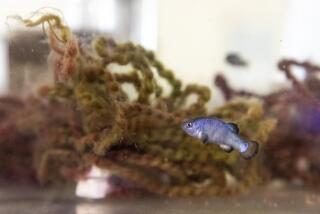Diablo Canyon reactor gets unwelcome guests
Strange, jellyfish-like creatures swarming a coastal nuclear power plant: It might sound like the premise of a cult horror flick, but the invasion has prompted officials at the Diablo Canyon facility in San Luis Obispo to curtail operations for at least a few days.
The plant’s operator, Pacific Gas & Electric, cut power generation from one of the plant’s two reactors to 25% of its capacity, spokesman Tom Cuddy said Wednesday. The other reactor was shut down this week for what PG&E described as routine refueling and maintenance, a procedure that could take about a month.
Workers on Monday discovered an influx of the creatures, called salp, clogging screens that are used to keep marine life out of the seawater used as a coolant, Cuddy said. Often thronging many square miles of ocean in huge, gelatinous masses, salp are tubular, transparent organisms that can be roughly the size of a human thumb. No one knows how many are at the Avila Beach plant or how long they will remain.
“We’ll continue to monitor the intake structure and clean the salp off the screens,” Cuddy said. “Once they decide to move on and it’s safe to do so, we’ll resume full power.”
That could take several days, he said, but no blackouts or interruptions are anticipated.
Jellyfish swarmed Diablo Canyon in 2008, triggering a steep, sudden decrease in power generation. Over the years, they have been a problem at nuclear plants in the U.S., Japan, Israel and Scotland. The San Onofre plant in northern San Diego County, while currently closed over several equipment issues, has not had a jellyfish problem, according to a spokeswoman for its operator, Southern California Edison.
Salps do not usually go coastal.
“Ordinarily they live further out at sea,” said Larry Madin, a salp expert and research director at Woods Hole Oceanographic Institution in Massachusetts. “It sounds like these were brought in on a current or blown in by wind.”
Salps live about a year. “They’re quite elegant animals,” Madin said. “They’re beautiful. They look like they’re made of cut glass, but they’re soft.” Research by Madin and his colleagues suggests that salps play a role in reducing greenhouse gases. They absorb carbon from plankton and drop it in heavy pellets to the sea floor, where it sits, instead of rising into the atmosphere as carbon dioxide.
When asked what he would advise for Diablo Canyon, Madin said, “Wait a few days. They’ll probably go away and probably won’t come back soon. They’re harmless — they don’t sting — but they’re not too good for power plants.”
Victor Dricks, a spokesman for the Nuclear Regulatory Commission, said the salp pose no threat to the plant. Curtailing operations while the creatures cling to the filters is a prudent move for PG&E, he said, because any potential shutdown is easier when the generator is at less than full power.
More to Read
Start your day right
Sign up for Essential California for news, features and recommendations from the L.A. Times and beyond in your inbox six days a week.
You may occasionally receive promotional content from the Los Angeles Times.







